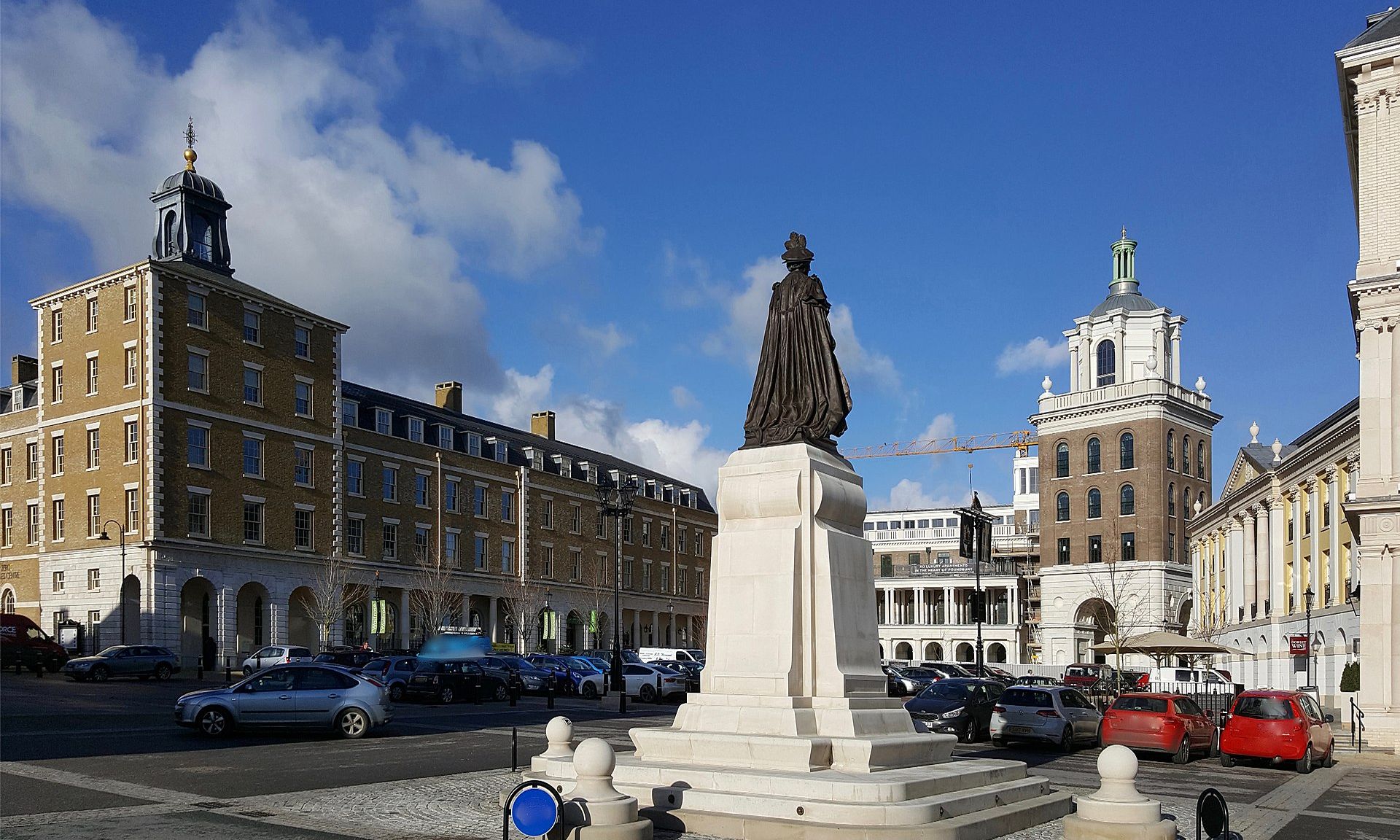The Main Square of Poundbury, a settlement on the outskirts of Dorchester built with keen endorsement from Prince Charles
Prince Charles has no doubt learned patience in his wait for the top job. He’s certainly a dab hand at playing the long game. His campaign against modern architecture began with a 1984 speech at London’s historic Hampton Court where he rubbished a proposed extension to the National Gallery as a “monstrous carbuncle”. The scheme was promptly dropped. As heir to the throne, he said, with no apparent self-consciousness, he saw it as a problem that the avant-garde had become the establishment. He went on to build Poundbury, his Classical-style model village outside the Dorset town of Dorchester. Charles also set up his Institute of Architecture among whose six founding principles was to “build beautifully”.
Alongside the prince were traditionalists such as the tweedy culture warrior Sir Roger Scruton, who blamed the dissolute 1960s for societal decay and believed, against all the evidence, that beauty was not only unchanging and eternal but linked to morality. This was amid the 1980s culture wars that set Thatcherism against the so-called political correctness of local councils.
Three decades later, the culture wars are again in full swing. The apoplexy with which governments have responded to calls to topple monuments since the death of George Floyd in May 2020 is not surprising but needs to be seen in this same context—a struggle for cultural hegemony.
This time around, the traditionalist lunatics have succeeded in taking over the asylum. Reactionary ideas hostile to the cosmopolitan, to Modernism, to modernity itself, are in the ascendant. Tory placemen (and they are generally men) are being appointed to the boards of cultural institutions such as the British Museum and the BBC. The thoroughly middle-class National Trust is under attack as “woke” for exploring colonialism (a similar report by English Heritage several years earlier provoked nothing like the same outrage). Laws are proposed that would hand out longer sentences for damaging a statue than for rape. A government “retain and explain” policy for monuments essentially amounts to retain everything and explain nothing.
This is not unique to Britain, of course—just look at Viktor Orbán in Hungary or the history wars in Poland, or the manufactured outrage by the Macron government over Islamo-gauchisme and mosques or other visual expressions of Islam. Switzerland, Spain and Denmark are among other countries gripped by minaret-phobia. In Germany and Eastern Europe, modern post-war city centres are being rebuilt as ersatz historic quarters full of fake traditional architecture. The same thing was happening under Donald Trump, who issued an executive order demanding that all new federal buildings be in a Classical style. Beauty and tradition have become dog-whistle words to white supremacists drunk on the Great Replacement conspiracy theory that sees a cultural genocide of Christian Europe at the hands of immigrants. Classicism is not inherently right-wing but traditional architecture has become a vehicle of choice for the Right and Far Right.
Traditionalist city-making ideas have been brewing for some time, now pushed by right-wing think-tanks such as the Policy Exchange and Legatum Institute, who are hostile to both public housing and fetters on the market, and whose adherents are now in government. Policy Exchange reports inspired the government’s Building Better, Building Beautiful Commission, headed by the late Sir Roger that pushed a traditionalist architectural agenda. Among the outcomes are proposed design codes for areas that would make it hard for council planners to resist developers who tick the codes’ boxes. A key figure is Scruton acolyte Nicholas Boys Smith, a former financier and adviser to former UK Prime Minister David Cameron, who succeeded Scruton at the Building Better Commission. He set up Create Streets, which champions traditional city-making, and is now an Historic England commissioner as well as heading up the government’s new Office for Place.
Despite explicitly aiming to promote beauty, the opposite is more likely because it all interlocks with a bonfire of planning controls. These make it easy, for example, to turn houses and offices into substandard housing without planning permission and reduce the public’s right to object to proposals. A planning White Paper would upend the post-war system creating simplified zones to encourage development. It is as if a Georgian speculative builder’s pattern book could be applied to the 21st century.
For the moment at least, the worst excesses of the style traditionalists have been frustrated: a proposed “fast track” through planning for development deemed beautiful seen as unworkable, for instance. The White Paper is being reviewed after the Tories lost last year’s Chesham and Amersham by-election, partly because of electors’ fears of the countryside being concreted. The direction of travel, however, remains.
Monuments, where values and historical narratives coalesce, are simply the obvious pointy end of this culture war. In many ways they are a distraction. In Britain at least, the insidious iceberg is traditionalism hand-in-glove with free marketeers intent on handing developers free rein.
• Robert Bevan is a member of the Mayor of London’s Diversity in the Public Realm Commission, which is holding a round table on contested heritage this month. He is writing in a personal capacity. His book, Monumental Lies: Culture Wars & the Truth About the Past, will be published later this year by Verso

